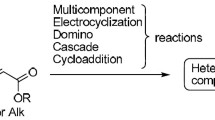Abstract
The electron-withdrawing groups (EWGs) in the electrophilic alkenes employed in the Michael addition reaction are almost only CO2R, CN, COR, NO2, and SO2Ph. Although amides (CONR1R2) are also typical electron-withdrawing groups and are of great importance in organic synthesis, they are scarcely employed as the EWGs of the electrophilic alkenes in the Michael addition reaction. In this work, the Michael reactions of acrylamide and its derivatives with cyclanones were successfully carried out in the presence of enough radical inhibitors. The amide groups play a key role in producing the preferred products. The N-substituted acrylamides, including N-monosubstituted and N,N-disubstituted acrylamides could react with cyclohexanone (CHn) to give the expected 2-carbamoylethyl derivatives; however, acrylamide reacting with cyclohexanone only produced ene-lactam. Cyclanones also have effects on the products, while the ring size of cyclanones influences the reaction yield and the α-substituent decides the ratio of resulting isomeric ene-lactams.
Similar content being viewed by others
References
Mase N, Watanabe K, Yoda H, Takabe K, Tanaka F, Barbas C F. Organocatalytic direct Michael reaction of ketones and aldehydes with β-nitrostyrene in brine. J Am Chem Soc, 2006, 128: 4966–4967
Inokuma T, Hoashi Y, Takemoto Y. Thiourea-catalyzed asymmetric Michael addition of activated methylene compounds to α, β-unsaturated imides: Dual activation of imide by intra-and intermolecular hydrogen bonding. J Am Chem Soc, 2006, 128: 9413–9419
Yamagiwa N, Qin H B, Matsunaga S, Shibasaki M. Lewis acid-Lewis acid heterobimetallic cooperative catalysis: Mechanistic studies and application in enantioselective aza-Michael reaction. J Am Chem Soc. 2005, 127: 13419–13427
Fonseca M T H, List B. Catalytic asymmetric intramolecular Michael reaction of aldehydes. Angew Chem Int Ed, 2004, 43: 3958–3960
Chen Q H, Geng Z. The new kind of an asymmetry Michael addition: Studies of the thermal elimination. Chin Sci Bull (in Chinese). 1993, 38(1): 94–95
Lu G, Zhang Q, Xu Y J. New development of the solvent-free Michael addition. Chin J Org Chem (in Chinese). 2004, 24(6): 600–608
Liu Z D, He X C. The Michael reaction under microwave irradiation. Prog Chem (in Chinese). 2006, 18(9): 1121–1129
Camara C, Keller L, Jean-Charles K, Joseph D, Dumas F. A Comparative study of high pressure versus other activation modes in the asymmetric Michael reaction of chiral imines. High Press Res, 2004, 24: 149–162
Bartoli G, Bartolacci M, Giuliani A, Marcantoni E, Massaccesi M, Torregiani E. Improved heteroatom nucleophilic addition to electron-poor alkenes promoted by CeCl3·7H2O/NaI system supported on alumina in solvent-free conditions. J Org Chem, 2005, 70: 169–174
Desmae1le D, Delarue-Cochin S, Cavé C, d’Angelo J, Morgant G. Asymmetric michael reaction involving chiral imines/secondary enamines: Stereocontrolled synthesis of 2,2-disubstituted tetrahydro-thiophen-3-ones. Org Lett, 2004, 6: 2421–2424
Camara C, Joseph D, Dumas F, d’Angelo J, Chiaroni A. High pressure activation in the asymmetric Michael addition of chiral imines to alkyl and aryl crotonates. Tetrahedron Lett, 2002, 43: 1445–1448
Yasuda M, Chiba K, Ohigashi N, Katoh Y, Baba A. Michael addition of stannyl ketone enolate to α, β-unsaturated esters catalyzed by tetrabutylammonium bromide and an ab initio theoretical study of the reaction course. J Am Chem Soc, 2003, 125: 7291–7300
Elad D, Ginsburg D. Acrylamide as an acceptor in the Michael condensation. J Chem Soc, 1953: 4137-4139
Murahashi S I, Takaya H. Low-valent ruthenium and iridium hydride complexes as alternatives to Lewis acid and base catalysts. Acc Chem Res, 2000, 33: 225–233
Murahashi S, Sasao S, Saito E, Naota T. Ruthenium-catalyzed hydration of nitriles and transformation of δ-keto nitriles to ene-lactams. J Org Chem, 1992, 57: 2521–2523
Naota T, Sasao S, Tanaka K, Yamamoto H, Murahashi S I. Selenium-and palladium-catalyzed oxidative cleavage of ene-lactams with hydrogen peroxide. Convenient methods for synthesis of macrocyclic ketoimides and N-fused azabicyclic compounds. Tetrahedron Lett, 1993, 34: 4843–4846
Lamblin M, Couture A, Deniau E, Grandclaudon P. A brief total synthesis of fumaramidine. Tetrahedron, 2006, 62: 2917–2921
Cotarca L, Delogu P, Nardelli A, Maggioni P, Bianchini R, Sguassero S, Alini S, Dario R, Clauti G, Pitta G, Duse G, Goffredi F. Efficient and scaleable methods for ω-functionalized nonanoic acids: Development of a novel process for azelaic and 9-aminononanoic acids (nylon-6,9 and nylon-9 precursors). Org Process Res Dev, 2001, 5: 69–76
Cotarca L, Delogu P, Maggioni P, Nardelli A, Bianchini R, Sguassero S. Efficient synthesis of ω-functionalized nonanoic acids. Synthesis, 1997, 3: 328–332
Murahashi S I, Sasao S, Saito E, Naota T. Ruthenium-catalyzed hydration of nitriles and transformation of ω-ketonitriles to ene-lactams: Total synthesis of (−)-pumiliotoxin C. Tetrahedron, 1993, 49: 8805–882
El-Barbary A A, Carlsson S, Lawesson S O. Enamine chemistry-XXIV: Synthesis, thiation, and reduction of lactams. Tetrahedron, 1982, 38: 405–412
Zhong X D, Ishifune M, Yamashita N J M S. Mechanistic study on polymerization of acrylamide induced by cyclohexanone based on the interaction between the carbonyl and amide groups. J Marcomol Sic-Pure Appl Chem, 1999, A36: 275–286
Lissi E A, Scaiano J C. Reaction of enamines, imines, and ketones with acrylamide. Chem Commun, 1971, 457–458
Author information
Authors and Affiliations
Corresponding author
Additional information
Supported by the National Natural Science Foundation of China (Grant Nos. 20374013 and 20674019), Program for New Century Excellent Talents in University (Grant No. NCET-04-0413), Science and Technology Commission of Shanghai Municipality (Grant Nos. 03JC14023 and 05DJ14005), “Shu Guang” Project of Shanghai Municipal Education Commission and Specialized Research Fund for the Doctoral Program of Higher Education (Grant No.20060251015)
Rights and permissions
About this article
Cite this article
Dai, W., Wang, C., Zhang, X. et al. Michael addition reactions of cyclanones with acrylamides: Producing 2-carbamoylethyl derivatives or ene-lactams. Sci. China Ser. B-Chem. 51, 1044–1050 (2008). https://doi.org/10.1007/s11426-008-0095-3
Received:
Accepted:
Published:
Issue Date:
DOI: https://doi.org/10.1007/s11426-008-0095-3



